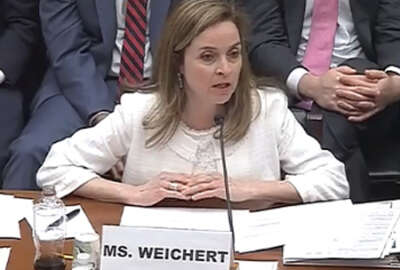Hubbard Radio Washington DC, LLC. All rights reserved. This website is not intended for users located within the European Economic Area.
OMB’s Weichert attempts to ease lawmakers’ concerns about OPM reorganization
Office of Management and Budget attempted to sell lawmakers on its reorganization proposals Wednesday. The proposal to reorganize the Office of Personnel Manage...
If Congress approved the administration’s new reorganization plan today, it would take three-to-five years to implement and execute the proposals, the Office of Management and Budget said Wednesday.
Lawmakers won’t, however, be able to approve the administration’s plan immediately, as many proposals will require congressional approval, a point OMB Deputy Director for Management Margaret Weichert made herself as she came to Capitol Hill Wednesday to sell the House Oversight and Government Reform Committee on her vision for government reorganization.
Senate Homeland Security and Governmental Affairs Committee Chairman Ron Johnson (R-Wis.) and Subcommittee Chairman James Lankford (R-Okla.) on Wednesday introduced legislation that would provide the administration authority to consolidate or eliminate agencies in the name of reorganization.
As expected, the proposals earned praise from some lawmakers and criticism from others.
“I would invite folks to actually meet us in the realm of public debate,” Weichert said. “Bring the facts, bring the alternative proposals. That’s probably the most important thing. We’ve attempted to create a holistic path forward. Is it perfect? Of course it isn’t. Does it have elements of challenge and difficulty? Absolutely. What we attempted to do was actually put together a plan that was a holistic vision. To the extent people disagree with that, I absolutely welcome that debate.”
Wednesday’s debate touched on a wide variety of proposals including the administration’s report, but lawmakers focused much of their attention on the plan to reorganize the Office of Personnel Management.
Several members, mostly Democrats, expressed concern with that plan. Of particular interest was the proposal to shift OPM’s current federal personnel policy offices to the Executive Office of the President.
As Weichert described, “elevating” federal personnel policy to the White House is the key to achieving the administration’s goals for the workforce.
Successfully re-skilling the federal workforce for new jobs of the future depends on the administration’s ability to create a central human resources office at the highest level of government, Weichert said. Preparing current federal employees for new jobs is critical, she added, because nearly 60 percent of the workforce is eligible for retirement in the next 10 years.
“What we don’t have is a challenge of too many federal workers to deliver the mission,” Weichert said. “What we do have is a skills alignment challenge and opportunity.”
Best listening experience is on Chrome, Firefox or Safari. Subscribe to Federal Drive’s daily audio interviews on Apple Podcasts or PodcastOne.
OPM in its current form lacks the time and resources to properly and strategically think about these HR challenges, Weichert said.
“Most of the people within OPM are effectively doing transaction processing related to HR paperwork,” she said. “They’re not thinking about these strategic issues. They’re not thinking about skills sets mismatches between the skills that were put in the [General] Schedule back in 1949 and what we need today.”
Weichert also maintained that the OPM reorganization would preserve federal merit principles.
In crafting its proposal to reorganize OPM, OMB researched government personnel systems within the Organization for Economic Cooperation and Development (OECD) countries that are similar to the U.S. Only one country — France — had an organization that managed government employees under a similar construct as OPM, Weichert said.
“[France] is not known to be a bastion of bureaucratic efficiency,” she said. “[For] every other major comparable country in the OECD, while they still had civil service principles and in some cases they may have had something like the Merit System [Protection] Board that we have … having it close to where decisions are made about budget and policy priority helped ensure that mission, service and stewardship were aligned with the workforce issues.”
“I have to note that you’re having it very close to where political decisions are made,” Del. Eleanor Holmes Norton (D-D.C.) said in the response.
Other members also expressed their concerns.
“What kind of safeguards will be in place to prevent nepotism — because we’ve definitely seen that operating in the close quarters of the White House and the Executive Office — [and] safeguards against political patronage in the executive branch?” asked Rep. John Sarbanes (D-Md.).
Moving OPM’s existing personnel policy offices to the White House and OMB isn’t such a big shift, Weichert argued. The federal chief information officer, controller and procurement policy administrator all reside within OMB, she said.
“Congress has actually put in safeguards around those key functions and elevated them into the Executive Office of the President precisely so that they can get the attention that Congress over time has felt it’s needed,” Weichert said. “The lack of an office of equivalent heft in the EOP for people is actually, in some ways, conspicuous by its absence.”
Reorganizing, not downsizing
Again, Weichert reiterated what’s become a common talking point for her: the reorganization plan is not a downsizing proposal.
After all, the administration will need buy-in from the federal employees who may be tasked with implementing these proposals, Weichert acknowledged.
“We do not disdain that workforce,” she said. “We applaud the work that the workforce does.”
Some members strongly expressed support for the administration’s ideas, including Rep. Virginia Foxx (R-N.C.), who serves as the chairman of the House Education and Workforce Committee but sits on the oversight committee and generally chaired Wednesday’s hearing.
“I think they forget, people in the agencies, often why they’re here,” she said. “They think the public is here to serve them. We’re here to serve the public. This is the beginning of a conversation, which Congress should engage in and not just discount out of hand the kinds of comments you made because the motives are questioned.”
But other lawmakers did question OMB’s approach in releasing the reorganization plans. The administration largely kept most of the proposals secret from the public and Congress until last week.
Weichert detailed at length the three phases the administration undertook to collect comments and ideas for reorganizing government.
The administration did not specifically ask federal unions to offer their own comments, she said. So few reorganizations have moved forward in government, because “entrenched interests” negotiated away meaningful reform ideas in the beginning process, Weichert added.
Federal unions have largely criticized the administration for not explicitly including them in reorganization preparation. The National Treasury Employees Union, for example, collected suggestions from its members and sent them to agency leaders. Leadership barely acknowledged NTEU members’ recommendations, the union said.
Weichert said OMB would discuss with agencies over the summer what proposals they could achieve administratively and which ones may need congressional approval or would appear in the 2020 budget. She did not, however, directly commit to giving Congress advanced notice of any reorganization proposal it may try to implement administratively.
Who’s missing?
The administration’s proposals largely ignored the Defense Department, a point that wasn’t lost on Rep. Jamie Raskin (D-Md.). He recalled a 2015 Defense Business Board audit, which found DoD could save nearly $125 billion by cutting some of its logistics and support functions.
The administration, however, said it wanted to focus reorganization efforts on agencies and missions that were particularly challenged.
“We looked at the areas where mission, service and stewardship were having the most challenges in moving forward,” Weichert said. “I absolutely appreciate the concerns, and we did look at GAO studies in that realm. In order to focus this activity, we wanted to look at those things where we had enough information.”
Copyright © 2024 Federal News Network. All rights reserved. This website is not intended for users located within the European Economic Area.
Nicole Ogrysko
Nicole Ogrysko is a reporter for Federal News Network focusing on the federal workforce and federal pay and benefits.
Follow @nogryskoWFED
Related Stories
Related Topics
Agency Oversight
All News
Civil Service Reform Act
Congress
Eleanor Holmes Norton
Federal Drive
Gerry Connolly
House Oversight and Reform Committee
Jamie Raskin
John Sarbanes
Management
Margaret Weichert
National Treasury Employees Union
NBIB Transfer to DoD
Office of Management and Budget
Office of Personnel Management
OPM Reorganization
Reorganization
Virginia Foxx
Workforce




